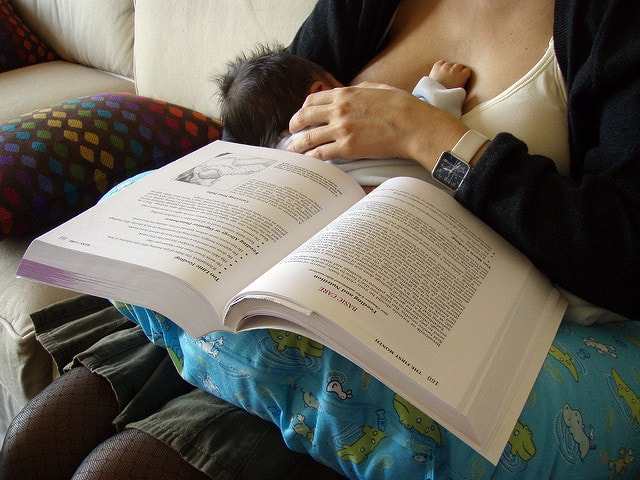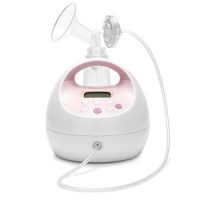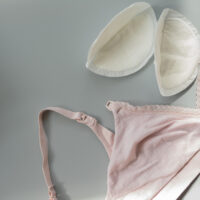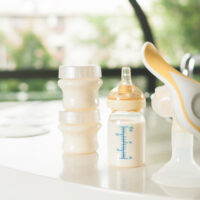I didn’t breastfeed my first two kids. I had been bottle-fed. I was perfectly healthy and had been first in my class, so I was skeptical about all the alleged benefits.
It wasn’t a few doubts about all the claims that turned me off about breastfeeding. It was the cult-like allegiance. It was the shaming culture. It was EVERYONE telling me I had to do it.
I admit, I’m independent and a bit of a contrarian. When the whole world seems to be all on one side of an issue, you can bet I’m going to investigate the other side.
In the case of breastfeeding vs formula feeding, the world has it mostly right. Breastfeeding has undeniable benefits. Every mom should seriously consider the merits of breastfeeding. Just look at this list!
But it never hurts to browse through the list of Challenges to Breastfeeding too, if for no other reason than to be able to casually mention at a dinner party that formula fed kids are less likely to develop peanut allergies. Then sit back and watch the fireworks.
Moms are adults. They are intelligent. They can make their own decisions. The bullying has to stop but the information has to flow. And that’s what this article is designed to do.
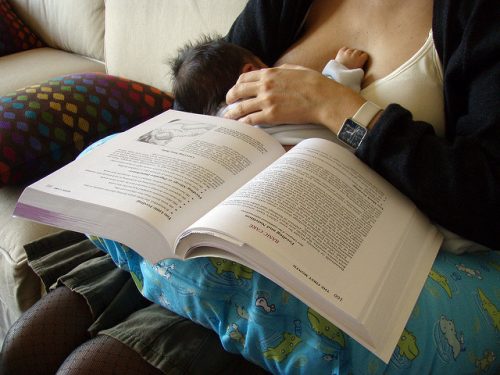
Best for Babies
1. Breastfed babies breathe better
Lung volume is greater in babies who were breastfed as opposed to formula fed babies, even if their mothers suffered from asthma. Reference
2. Breastfed babies have better teeth and fewer cavities
Breastfed babies have better dental health and need less orthodontic work. Reference
3. Cholesterol levels are reduced in breastfed babies through adulthood
Academic studies have shown that breastfed babies have healthier hearts and that breastmilk contributes to lower cholesterol levels in childhood and throughout life. Reference
4. Meconium is passed more easily in breastfed babies, reducing jaundice
The colostrum in breastmilk has a laxative effect and helps babies to pass the sticky meconium which helps prevent jaundice. Reference
What is the best breast pump for comfort and portability?
5. Breastmilk is a natural immunization
Breastmilk has antibodies which protect against infection and act as baby’s first immunization.
How does mom’s body know which antibodies to produce? In addition to general antibodies the mother already has developed in her bloodstream, Dr. Linda Palmer explains that mom’s milk is able to provide “made-to-order antibodies” for any viruses or bacteria that are currently challenging baby. The mother’s body becomes aware of those bugs as she is “exposed via saliva entering through pores in the areola as well as through breath and kisses.”
6. Many breastfeeding benefits are lifelong
Breastfeeding saves lives and protects babies in infancy and beyond. It provides proven long-lasting benefits to health and development throughout a child’s life. Reference
7. Breastfed babies need fewer doctor’s visits
Because of the protective benefits in breastmilk, breastfed babies require fewer doctor’s visits and fewer admissions to hospitals. Reference
8. Breastfed babies see better
Children studied through the age of 6 were shown to have better vision than those who were formula fed. Reference
9. Babies are less likely to suffer from cardiopulmonary distress while feeding
Bottle fed babies can suffer cardiopulmonary disturbances while feeding due to repeated swallowing, a risk which is not an issue for a breastfed baby, thus they suffer less cardiopulmonary distress. Reference
10. Breastfed babies may have lower childhood blood pressure
Research has shown that children tested in later childhood had lower blood pressure if they had been breastfed, and this is also the case for adults’ blood pressure after breastfeeding. Reference
11. There are fewer oral misalignments in breastfed babies
Babies who are breastfed have fewer misalignments of the jaw and palate, and the longer they are breastfed the less at risk they are. This seems to be partially related to the sophisticated level of muscle movement involved in breastfeeding. Reference
12. Breastfed babies have a lower risk of developing inguinal hernia
It’s not known exactly why breastfed babies develop fewer inguinal hernias than bottle-fed babies but it is probably related to the hormones passed on to the baby from breast milk. Reference
What is the difference between the Spectra S1 and S2 breast pumps?
13. There is less chance of breastfed babies contracting Haemophilus bacteria
This illness is caused by bacteria forming in the respiratory tract, spreading to the throat, ears or blood. Children who were breastfed are much less vulnerable to this bacteria, even in later childhood. Reference
14. Breastfed babies are less liable to die before the age of three
Breastfed babies are less likely to develop life-threatening illnesses and have better protection against ailments that do occur. Reference
15. Breastfeeding promotes muscle development in a baby
The muscle development of babies, particularly in preterm babies, is shown to be enhanced in breastfed babies. Reference
16. Babies recover better from jaundice when breastfed
Newborn babies can become constipated and the colostrum in breast milk acts as a laxative. If the baby doesn’t pass stools, the bilirubin present in stools can pass back into the system and exacerbate jaundice. Reference
17. There is a lower rate of Crohn’s disease in breastfed babies
There is research that shows that breastmilk can protect against the intestinal disorder, Crohn’s Disease. Reference
Which of the two most popular breast pumps is best?
18. The incidence of autoimmune thyroid disease is reduced by breastfeeding
Both mother and baby have less chance of developing thyroid problems after breastfeeding. Reference
19. Breastmilk has many benefits for premature babies
Many associations dedicated to the care and research of preterm babies have called for breastfeeding to be a standard of care for these vulnerable infants because of the numerous health and developmental benefits. Reference
20. There are fewer cases of multiple sclerosis among breastfed babies
One of the causes of MS is a breakdown of myelin, and breastmilk is known to contribute to myelin formation, which may explain why mothers and babies who have breastfed for more than 15 months are less likely to develop the condition. Reference
21. Breastfeeding babies develop less anemia
There is enough iron in a baby’s body and in breastmilk to provide all a baby needs. A higher hemoglobin level has been found in breastfed babies at six months than formula fed babies at the same age. This has been shown to prevent iron deficiency which can lead to anemia. Reference
22. There are fewer cases of septicemia in breastfed babies
Even partial breastfeeding provides a proven protection against septicemia. Reference
23. Studies show schizophrenia can be arrested somewhat by breastfeeding
Breastmilk improves mental health and brain development in babies and this may have an influence on the significant reduction of schizophrenia in breastfed babies. Reference
24. Breastfeeding gives babies a better chance against SIDS
Breastfed babies are statistically proven to be at a lower risk from Sudden Infant Death Syndrome. Reference
25. Babies are less likely to suffer from type I and II diabetes if breastfed
Scientists have found an 18% reduction in diabetes among children who have been breastfed. Reference
26. There is less chance of a breastfed baby developing necrotizing enterocolitis
This disease mostly affects premature or sick newborn babies. It affects the lining of the intestine which dies and falls off in a baby suffering from NEC. Research has found that 83% of cases can be directly associated with a lack of breastfeeding. Reference
27. Breastmilk is the only source for colostrum
Colostrum is present in early breast milk and has many preventitive and life enhancing properties which are of particular benefit to a baby’s growth and development. Its composition has never been replicated in a manmade form. Reference
28. Breastmilk allows a safer absorption of iron
A baby is born with iron stores which will last until solid food is introduced, and breastmilk has the perfect amount of iron in it to complement the stores in the baby’s body. Reference
29. Breastfed babies gain weight at a healthier speed
By six months, breastfed babies tend to weigh less than formula fed babies, but studies have found this extra weight to be due to water retention and a different composition of body fat rather than an all-around healthier baby. Breastfed babies gain weight steadily and more appropriately. Reference
30. Breastmilk provides all the food and liquid a baby needs
Whatever the temperature, breastmilk has all the nutrition and water that a baby needs, so your baby requires no supplementary feeding for the first six months of life. Reference
31. Breast milk contains valuable fatty acids
The fatty acids in breast milk are essential for baby’s health and brain development as well as calorie intake. Breast milk is rich in these fatty acids which helps vitamin absorption as well as nervous system development. Reference
32. Premature babies thrive on breastmilk
The research on the benefits of breastmilk on brain development is well known, and this seems to be particularly true for premature babies who show better neurobehavioral patterns when breastfed and respond to the affectionate closeness that the action of breastfeeding provides. Reference
33. Breast milk is rich in antioxidants
Breast milk is full of beneficial properties, one of these being cancer preventing antioxidants. Reference
34. Vaccines are more effective in breastfed babies
There is evidence that responses to oral and parenteral vaccines are more postive in breastfed babies. Reference
35. Breastfed babies have less reflux
Newborn babies who are breastfed suffer less from gastrooesophageal reflux (spit up) than formula fed babies, and suffer for a shorter period of time. Reference
36. Breastfed babies aren’t exposed to the aluminium that can be present in formula
There can be aluminium and trans fats present in some formula milks which can cause inflammation of parts of the body including the brain. Breast milk does not contain such toxins. Reference
37. The composition of breastmilk has perfect proportions of all food groups
Breastmilk is perfectly designed to offer protein, carbohydate and fat, and the amounts of these food groups adapt as a baby grows. Reference
38. Breasts are nature’s pacifiers
Some babies need to suck a great deal and breasts can be used instead of an artificial pacifier which can interfere with latching on and produce breast problems. Reference
39. Breast milk has pain relieving properties
The endorphins in breast milk can suppress pain for the baby, and this can be vital when the baby is in pain or enduring a minor painful procedure. The act of feeding seems to be valuable in reducing crying time and a reduction in pain felt by the baby. Reference
40. Breastmilk adjusts to what your baby needs
Breastmilk adapts to the needs of an individual baby, and changes throughout the day. Production adjusts to how much the baby requires. Mothers should eat a healthy diet while breastfeeding but the baby will always take what it needs. Reference
41. Zinc and other minerals are extremely bioavailable in breast milk
Breastmilk provides all the nutrients a baby needs in balanced and appropriate propotioins, including zinc, iron and copper. Reference
42. Breastfed babies have beautiful skin
Breastfed babies have softer, smoother skin as a result of the different fats present only in breast milk. Some pediatricians are able to identify a breastfed baby by the quality of their skin. Reference
43. Breastfed babies can’t be overfed, but bottles tend to be given until empty
Healthy babies take what they need from the breast and will eat what they need and stop when they are satisfied. A formula fed baby’s parents seem concerned with a bottle being emptied which can lead to overfeeding. Reference
44. There are no melamine toxins in breastmilk
Melamine in formula milk has been responsible for a small number of infant deaths and numerous hospitalizations. Breastmilk is completely free from melamine. Reference
45. Breastfed babies are less picky when introduced to solid food
Breastmilk has many different flavors, so when introduced to solids the new tastes are less of a shock to a breastfed baby. Reference
46. Breastfed babies are at lower risk of obesity
The results are a bit mixed on this one because results of studies are somewhat conflicting, but many believe breastfeeding will make it less likely that your child becomes obese. Reference
47. Breast milk is made specifically for babies, while cow’s milk is made for calves
Each species of mammal produces milk that is tailored to that animal, hence human milk is designed for a human baby, whilst cow’s milk is made for a baby cow and the composition and consistency is perfect for a calf, not a human. Reference
48. Breastmilk has a better flavor
Breastmilk is sweet, light and creamy compared to a blander flavor in formula milk. Reference
49. Breastfed babies less likely to have snoring and sleep apnea problems
In a study of families with asthma it was found that breastfed children were less likely to develop sleep apnea and snoring problems. It is speculated that the reason is related not to breast milk but the physical exercise of breast suckling which has a positive impact on the mouth and jaw structure. Reference
50. Breastfed babies need shorter periods of fasting pre and post surgery
A baby can be breastfed up to three hours before elective surgery if they are in good health. Reference
51. Breast milk provides protection against toxins from the environment
Even if toxins are present in the everyday environment, breast feeding still provides protection and has only been deemed dangerous if the mother is clinically ill from toxic poisoning. Reference
52. Breastmilk has benefits that last through childhood
The health giving and nutritional benefits of breastfeeding lead to much healthier children as they grow and develop. Reference
53. Breastfeeding reduces the incidence of ulcerative colitis
Breastfeeding may reduce the chances of getting ulcerative colitis. While the results in this study were positive, more research is still required. Reference
54. Urinary tract infections are reduced in breastfed babies
The anti-infection properties of colostrum have shown a significant reduction in UTIs in newborns, and breastmilk given until 7 months also showed fewer urinary infections in babies. Reference
55. There is never harmful bacteria in fresh breastmilk
Breastmilk contains antibacterial properties which limits the growth of harmful organisms in the baby’s gut. Reference
56. Breastfeeding encourages microflora production in the baby’s stomach
These microflora are unique to breastmilk and they significantly contribute to improving baby’s health in the short and long term. Reference
57. There are fewer cases of bacterial meningitis among breastfed babies
The protective properties of breastmilk help to reduce incidences of bacterial meningitis in children. Reference
58. Your baby is far less likely to get gastrointestinal infections or diarrhea if breastfed
Diarrhea kills many babies each year, particularly in the Third World and six months of exclusive breastfeeding is proven to reduce the risk of gastrointestinal infections by half. It is estimated that breastfeeding saves 6 million infant lives each year, as breastmilk contains lactoferrin which dramatically acts on bacteria in a baby’s stomach. Reference
59. Breast milk can be used to treat eye infections successfully
Babies with eye infections recover faster when treated with breastmilk on the eye rather than antibiotics. Some hospitals now adopt this treatment as standard practice. Reference
60. Breastmilk protects against ear infections
One month of breastfeeding can reduce the likelihood of ear infections by 4%, and 6 months of breastmilk reduces the odds by 17% according to medical research. . Reference
61. Breastfed babies suffer from fewer respiratory infections
If a baby is breastfed for 6 months or more, there is significant protection against colds and even pneumonia. Reference
62. Babies who have been breastfed are less likely to suffer from lymphoblastic leukemia
Breast milk has cancer reducing properties, and it has been found that a child who was breastfed for 6 months or more has a 19% lower chance of contracting leukemia. If a child has had less exposure to breastmilk the reduction is still 11%. Reference
63. Girls who have been breastfed are less likely to develop breast cancer in later life
The American Cancer Society has found that babies who have been breastfed, even only for a short time, are 25% less likely to develop pre and postmenopausal cancer in later life. Reference
64. Breastfed babies are less likely to contract Hodgkin’s Lymphoma
If a baby is breastfed for 8 months or more they appear to be significantly protected against Hodgkin’s disease. Reference
65. Babies who have been breastfed are less likely to develop Wilm’s tumor
Any exposure to breastfeeding appears to reduce the likelihood of a child suffering from Wilm’s tumor, a cancer of the kidney that affects toddlers. Reference
66. There are lower incidences of neuroblastoma in breastfed babies
There is a substance found in breast milk called TNF-related apoptosis inducing ligand (TRAIL), which helps prevent central nerous system cancers such as neuroblastoma. Reference
67. Breast milk contains cancer killing proteins
There is a protein found only in breast milk that actually kills cancer cells. This protein, apha-lactalbumin (alpha-lac for short), helps produce the sugary lactose in breastmilk. Reference
68. No other animal milk is higher in lactose than breastmilk, and lactose is vital to brain growth
Exclusive breastfeeding is proven to increase a baby’s brain growth by 20-30%. Reference
69. Breastfeeding seems to reduce childhood bed wetting
Neurodevelopment is vastly improved in breastfed babies, and one of the consequences of this is that children who have been breastfed for more than 3 months, wet the bed for a much shorter time if at all, compared to those who had been breastfed for less time or bottle-fed. Reference
70. Speech development is improved by breastfeeding
Suckling on the breast improves muscle tone in the face and mouth and this promotes speech development and helps with speech problems. Reference
71. Breastfed babies develop better socially
Medical research shows that cognitive development is greater in breastfed babies, and this continues through life, meaning that social status is improved and a breastfed adult is less likely to be lower down the social scale. Reference
72. Children who are breastfed are less likely to develop autism
Research has shown that children who are bottle-fed or only breastfed for a short period of time are more likely to develop ASD than babies who had longer periods of breastfeeding. Reference
73. A baby who is breastfed will have a higher IQ
Research shows us that the brain development of children is improved by breastfeeding, and the result of this is that breastfed children have on average a 4% higher level of IQ than their formula fed counterparts. Reference
74. Breastfeeding improves hand eye coordination
Breastfeeding allows a variety of movement and position for the baby which encourages growth in early development of hand eye coordination. . Reference
75. Breastfeeding babies settle better at night
The ease and immediacy of breastfeeding means that babies are fed and settled more quickly during night time feeds, meaning they gulp less air and become less distressed while waiting. Reference
76. A breastfed baby is less likely to suffer from Celiac disease
Doctors found that babies who were still being breastfed when gluten was introduced into their diet were more than half as likely to suffer from Celiac Disease. Reference
77. There is less incidence of eczema in breastfed babies
A baby who has been breastfed exclusively for a significant period of time is more than half as likely to be free from eczema by the age of 16. Reference
78. There is a lower chance of a child developing food allergies if they have been breastfed
If a baby has been breastfed for four months or more they are much less likely to have a food allergy, especially if they were a high risk baby. Reference
79. Breastfed babies have a better chance of not having asthma
Medical studies show that breastfed baby are less likely to suffer from asthma than formula fed babies. Reference
Best for Mom
80. Breastfeeding helps a mother and baby bond
The hormones released when feeding are part of the bonding process, but the physical closeness of the baby on your breast and the satisfaction of knowing you are providing such a wonderful start for your baby do help enormously with bonding. Reference
81. Breastfeeding and breastmilk soothe your baby and you too
Your baby is comforted by the closeness of your skin and your natural scent, hears your heart beat and hears the familiar sound of your voice. This is the perfect environmentn for your baby to develop and be nurtured. Reference
82. Your baby wants your breast milk
Breast milk is specifically designed by God to taste great so it is a safe bet that your baby will love it. Reference
83. Breastfeeding releases the ‘love hormone’ oxytocin, giving the mother a wonderful feeling as she nurses
Oxytocin is produced by breastfeeding which gives you a feeling of wellbeing as you feed and encourages the bonding feeling. Reference
84. Breastfeeding is correlated to moms who pay more attention
Moms who breastfed their children seem more likely to be sensitive to other needs their children have later in life, according to this study. Reference
85. Breastfeeding gives an excuse for lots of cuddles every day
Not only is feeding a great excuse for cuddles, it allows you to sit down and relax for a while and just enjoy mother and baby time. Reference
86. Breastfeeding mothers seem to have a stronger response to a baby’s cry
The bonding effects of breastfeeding are well known, but it has been scientifically proven that a breastfeeding mother’s brain produces a greater response to a baby’s cry in the regions that govern caregiving and empathy. Reference
87. Mothers who breastfeed get more sleep
There is less equipment to prepare and clean with breastfeeding, there’s no need to move far to feed and the hormones that are produced by breastfeeding encourage sleep for the mother. Reference
88. Breastfeeding gives confidence to a mother
There is nothing as satisfying than looking at a healthy baby and knowing that you have provided all that baby has required to grow. Provided mothers have the correct support system, there is a natural boost to her self-confidence from breastfeeding. Reference
89. Breastfeeding enhances your breasts
Breasts can often seem larger during breastfeeding due to engorgement, but once you finish feeding, the milk producing tissue in the breast is replaced by fatty tissue, giving the breasts a fuller feel and appearance. Reference
90. Hormones released during breastfeeding help shrink your uterus
Hormones are produced in the mother’s body in order to produce breastmilk and one of those hormones actually promotes the shrinking of the uterus post birth. Reference
91. Breasts are perfectly designed to feed a baby
The composition of a woman’s breast is naturally designed to breastfeed. The nipple fits into a baby’s mouth and offers maximum milk exposure and the areola secretes a natural lubricant for breastfeeding. Reference
92. Breast feeding can offer a better night’s sleep for dad
Breastfeeding mothers can easily access their baby without the need for prolonged crying which could disturb dad. There are no bottles to get or heat up so less activity preventing sleep. Reference
93. Breastfeeding can calm toddlers during tantrums
A toddler can be calmed effectively by sucking on the breast, and the milk has a pacifying effect in its natural composition. Reference
94. There are hardly any medications that are contra indicative to breastfeeding
The American Academy of Pediatrics, which provides guidance to doctors, recommends that the majority of medicines and immunizations are completely safe for mothers who breastfeed. Reference
95. Child spacing can be aided by breastfeeding
Breastfeeding is not a safe contraceptive alone, but breastfeeding women often do not ovulate during the first 6 months of exclusive breastfeeding. Night feeding seems to encourage longer amenorrhoea (lack of periods). While these indicators cannot prevent subsequent pregnancies 100%, breastfeeding does contribute to optimum child spacing. Reference
96. Breastfeeding reduces stress in the mother
Mothers enjoy a sense of well being from hormones produced when they breastfeed. As long as a mother isn’t suffering from extreme stress there is a beneficial effect on her. Reference
97. Breastfeeding is a natural tranquilizer for the mother
Nursing a baby produces relaxing hormone in the mother’s bloodstream and mothers report falling asleep as they feed. Even the process of expressing is a calming influence as it also reduces blood pressure and keeps a mother calm. Reference
98. Breastfeeding helps mothers to give up smoking
Even if women are smokers when they begin breastfeeding, the action of feeding seems to encourage mothers to give up. Reference
99. Breastfeeding mothers are less likely to suffer from ovarian cancer
Mothers who breastfeed for 1-2 years are one third less likely to develop ovarian cancer. Reference
Which formula is best for lactose intolerant infants?
100. Breastfeeding can prevent post partum hemorrhage
The calm and closeness of early feeding as well as the hormone produced by feeding, encourages the placenta to be expelled quickly and blocks off blood vessels that can cause post partum hemorrhage. Reference
101. Breastfeeding may help women who have suffered from endometriosis
Mothers who have suffered from endometriosis, report an improvement in their condition after breastfeeding and some even claim they have been cured for good. Reference
102. Diabetic mothers need less insulin when breastfeeding
Mothers who suffer from diabetes need less insulin than comparible mothers who bottle feed. Reference
103. There is less chance of a mother getting lupus if she breastfeeds
The risk of an autoimmune disease, in particular lupus, is reduced in a mother who has breastfed for 13 months or more. Reference
104. Breastfeeding mothers tend to have lower blood pressure
If a woman has breastfed she seems to be less likely to suffer from raised blood pressure later in life and post menopause. Reference
105. Mothers get less cardiovascular disease after breastfeeding
Breastfeeding helps a mother’s blood pressure and helps reset her metabolism after pregnancy, which gets rid of stored fat. These benefits seem to promote heart health and give a mother less chance of cardiovascular disease in the future. Reference
106. Mothers tend to have improved mental health when breastfeeding
The production of hormones and the reduction of inflammation that breastfeeding induces in the mother’s body, seems to have a positive impact on a mother’s mental heallth. Reference
107. Breastfeeding can be beneficial for women with post partum depression
In a large study of many women postpartum depression was recorded as being greater in women who did not breastfeed. Reference
108. Breastfeeding mothers develop fewer cases of breast cancer
Studies have been undertaken in many countries and there is strong evidence that women who have breastfed have significantly less chance of contracting breast cancer in later life. Reference
109. There is less chance of a breastfeeding mother developing endometrial cancer
It has been shown that prolonged breastfeeding reduces the chance of a woman getting endometrial cancer. Reference
110. Mothers are at less risk of developing metabolic syndrome if they have breastfed
The longer a mother breastfeeds in her lifetime, the less chance she has of developing metabolic syndrome and related conditions such as blood pressure, according to medical research. Reference
111. Breastfeeding mothers are less likely to develop rheumatoid arthritis
Statistics show that breastfeeding reduces the risk of rheumatoid arthritis, by 20% for mothers who breastfed for 1-2 years and by 50% in mothers who have breastfed for 2 years or more. Reference
112. Breastfeeding mothers save money on menstrual supplies
As your periods tend to start later when you are breastfeeding, you will save money on menstrual supplies and help the environment by not contributing to landfill with packaging and other waste. Reference
113. Breast milk is free, formula isn’t
When you consider the cost of milk, bottles and other supplies and lost days of work due to less healthy babies, formula feedings costs a family a lot of money that is not spent in families where breastfeeding has occurred. Reference
114. Breastfeeding mothers take less time off work as a result of childhood illnesses
Breastfed children tend to be sick less, so working mothers need less time off work to look after them and this is a value that is recognised by employers. Research shows that the GDP of some countries could be improved if more working mothers breastfed. Reference
115. Returning to work is no barrier to breastfeeding
Mothers can continue to breastfeed if they return to work. They can either express at work, or leave enough expressed milk for the caregiver and then feed the baby themselves when at home. Reference
116. There is no equipment to carry around except your breasts!
There is a simplicity about breastfeeding. There are no bottles or milk powders to carry around, it’s just a question of putting the baby to your breast and getting on with it. Reference
117. Women who breastfeed exclusively tend to wait longer before their periods restart
Breastfeeding women produce hormones that discourage the body from ovulating or menstruating, so the more a mother feeds, the more of these hormones will be produced. Reference
118. No mixing, heating, filling; breast milk is ready when baby is
Breasts are kind of like cement trucks. They keep everything mixed up and perfectly ready to go. Plus, come to think of it, they look like those trucks too. Reference
119. Breasts don’t need sterilizing unlike formula bottles
Fresh breast milk is always sterile and requires no mixing or heating unlike formula. Reference
120. However full or empty your breasts feel, there is always milk available
Breast milk is produced on demand but even if a baby has a small appetite and the breasts aren’t prompted to make much milk, enough will always be available to meet a baby’s needs. Reference
121. Breast milk doesn’t stain clothing
There are bound to be spillages when feeding, but breast milk doesn’t leave the same stains that formula does. It washes away completely with no residue or mark. Reference
122. Multiple births are no barrier to breastfeeding. Breast milk is produced on demand , so you can breastfeed twins, triplets or more
Your body will produce as much milk as is demanded by your baby or babies. If you have carried multiple babies your body will be preparing more milk. If the demand is high, your body will recognise this and there will be enough milk for you to feed more than one child. Reference
123. Breastfeeding a baby is quicker than formula feeding
Breastfeeding can be done at a moment’s notice, there’s no need to do any preparation, so you are much freer to just get up and go when you need to. Reference
125. Diaper changes are much nicer when a baby is breastfed
There is a nicer odor to the stools of a breastfed baby than a formula fed one. Nicer smells produce better reactions from the diaper changer, so a baby sees more positive smiley faces and picks up good messages. Reference
126. Mothers lose baby weight quicker if they’re breastfeeding
Breast milk contains a lot of fat and this can come from the mother’s supply, and as long as the mother sticks to a healthy diet this can help her to lose the fat stored in pregnancy. Reference
127. There is no reason to formula feed upon return to work
There are many ways to make it work if you return to your job while you are breastfeeding. If you live close by you can return home to feed, or express milk for a caregiver and feed when you return home. Reference
128. Breastfeeding burns 500 calories per day
Breastfeeding burns calories and is one of the easiest ways to keep the weight off.
129. Breast milk is produced at the perfect temperature
Breast milk is always available and always at the optimum temperature for baby, at any time of day or night. Unlike formula it doesn’t require any preparation, or run out. Reference
130. Nighttime feeding is easier with breastfeeding
The levels of milk producing hormone are higher in a mother’s body at night, so there is a stronger milk supply built up from night feeding. The feel good hormone that the mother produces while feeding also helps her to relax and sleep after feeding. Reference
131. Your baby can recognize you from the scent of your breast milk
Babies apparently have a keen sense of smell. One studied showed that newborns can tell the difference in the smell of their mother’s milk and other mother’s milk. Reference
132. Breast milk is more flexible than you think
Yes, breastfeeding can be a bit awkward until you get used to it. But you can also pump and store milk making it a more flexible feeding alternative than you might have guessed.
Best for All
133. The American Academy of Pediatrics promotes breastfeeding
The AAP encourages breastfeeding as the optimal infant nutrition. They believe it is a public health issue and not just a lifestyle choice. Reference
134. The World Health Organization and UNICEF both recommend breastfeeding
Major global health organizations publicly recognize the benefits of breastfeeding, not only for nutrition but also for the enormous health benefits. Exclusive breastfeeding is promoted for the first 6 months of life, but is also recommended as a supplement to solid food until at least the age of two. Reference
135. The American Dietetic Association is pro-breastfeeding
The ADA believes that exclusive breastfeeding is best for the first 6 months and then should be continued until 12 months, supplemented by other foods. Reference
136. There is no delineation in class or income when breastfeeding
Breastfeeding is a great leveler between rich and poor and those at the top and bottom of the social scale. It’s simply providing the best for your baby at no cost at all. Reference
137. Breastfeeding is fashionable and advocated by famous mothers
Not only does up to date research promote breastfeeding as the best choice, but high profile mothers have improved the image of breastfeeding and the drive towards a more environmentally and organic lifestyle in the current age, making breastfeeding a more popular choice. Unfortunately, it has gone a bit far and is almost cult-like. Reference
138. Breastfeeding is good for the environment
Breastfeeding doesn’t have the waste products that formula feeding has. Reference
139. Formula milk costs the government and the taxpayer millions
Formula milk costs millions of dollars in free milk given to low income families and also in health costs associated with children who have been formula fed. Reference
140. Breastfeeding means less transportation cost and environmental concerns
Breastfeeding negates the need for a catalogue of packaging, delivery and waste, which has an overall positive impact on the environment. Reference
141. Health care providers save millions as a result of breastfeeding
The reduction in child health issues and breast cancer rates in breastfeeding mothers and their babies saves millions to health providers each year. Reference
References
1. Dogaru CM, Strippoli MF, Spycher BD, Frey U, Beardsmore CS, Silverman M, Kuehni CE. Breastfeeding and lung function at school age: does maternal asthma modify the effect? Am J Respir Crit Care Med 2012;185:874880.; Ogbuanu IU, Karmaus W, Arshad SH, Kurukulaaratchy RJ, Ewart S. Effect of breastfeeding duration on lung function at age 10 years: a prospective birth cohort study. Thorax 2009;64:6266.; Nagel G, Buchele G, Weinmayr G, Bjorksten B, Chen YZ, Wang H, Nystad W, Saraclar Y, Braback L, Batlles-Garrido J, et al.. Effect of breastfeeding on asthma, lung function and bronchial hyperreactivity in ISAAC Phase II. Eur Respir J 2009;33:9931002.; Soto-Ramirez N, Alexander M, Karmaus W, Yousefi M, Zhang H, Kurukulaaratchy RJ, Raza A, Mitchell F, Ewart S, Arshad SH. Breastfeeding is associated with increased lung function at age 18 years: a cohort study. Eur Respir J (In press)
2. http://www.brianpalmerdds.com/pdf/caries.pdf
3. https://www.livestrong.com/article/103144-cholesterol-breastfeeding/
4. https://www.ncbi.nlm.nih.gov/pubmed/8963629
http://www.aafp.org/afp/1999/1101/p2043.html
5. https://www.sciencedaily.com/releases/2008/10/081026101713.htm
6. https://www.unicef.org.uk/babyfriendly/what-is-baby-friendly/the-benefits-of-breastfeeding/
7. https://www.webmd.com/parenting/baby/nursing-basics#1
8. January 2007 issue of American Journal of Clinical Nutrition
9. Koenig HS, Davies Am, Thach BT. “Coordination of breathing, sucking and swallowing during bottle feedings in human infants.” J Appl Physiol 69: 1629: 1623-1629, 1990. Matthew O, Clark ML, Ponske MH. Apnea, bradycardia, and cyanosis during oral feeding in term neonates.” J Pediatr 106:857, 1985
10. Martin RM et al (2004). “”Does Breast-Feeding in Infancy Lower Blood Pressure in Childhood?”” The Avon Longitudinal Study of Parents and Children (ALSPAC). Circulation 109
Martin RM et al (2005). “”Breastfeeding in Infancy and Blood Pressure in Later Life: Systematic Review and Meta Analysis.”” American Journal of Epidemiology 2005 161 (1): 15-26
11. Pediatrics journal June 15 2015
12. Pisacane, A. “”Breast-feeding and inguinal hernia”” Journal of Pediatrics 1995: Vol 127, No. 1, pp 109-111 Pisacane, A. “”Breast-feeding and inguinal hernia”” Journal of Pediatrics 1995: Vol 127, No. 1, pp 109-111
13. Silfverdal et al, “”Protective effects of breastfeeding: an ecological study of haemophilus influenzae (HI) meningitis and breastfeeding in a Swedish population.”” Int J Epidem 1999; 28:152-6
Cochi SL, Fleming DW, Hightower AW, et al. “”Primary invasive Haemophilus influenzae type b disease: a population-based assessment of risk factors.”” J Pediatr. 1986;108:997-896
Istre GR, Conner JS, Broome CV, et al. “”Risk factors for primary invasive Haemophilus influenzae disease: increased risk from day care attendance and school-aged household members.”” J Pediatr. 1985;106:190-198
14. Van Den Bogaard, C. “Relationship Between Breast Feeding in Early Childhood and Morbidity in a general Population.”Fan Med, 1991; 23:510-515
16. http://www.nature.com/articles/7210629.pdf
17. https://academic.oup.com/ajcn/article/80/5/1342/4690441
18. https://kellymom.com/health/mom-health/thyroid-faq/
19. https://signec.org/hm-policy-statements/
20. Breastfed babies become healthier adults See more at: https://www.bellybelly.com.au/breastfeeding/breastfeeding-multiple-sclerosis/
21. https://www.askdrsears.com/topics/feeding-eating/family-nutrition/iron/8-ways-prevent-anemia
22. https://www.ncbi.nlm.nih.gov/pmc/articles/PMC1792983/
23. https://www.ncbi.nlm.nih.gov/pubmed/12576752?dopt=Abstract
24. https://www.nichd.nih.gov/health/topics/sids/conditioninfo/reduce
25. https://www.rcm.org.uk/news-views-and-analysis/news/breastfeeding-can-help-prevent-diabetes
26. Updegrove, K “Necrotizing Enteroclolitis: The evidence for use of human milk in prevention and treatment.” J Hum Lact 2004; 20: 335-339; Drane, D. “Breastfeeding and formula feeding: a preliminary economic analysis” Breastfeed Rev 1997; 5:7-15; Convert RF, Barman N, Comanico RS, et al. “Prior enteral nutrition with human milk protects against intestinal perforation in infants who develop necrotizing enterocolitis.” Pediatr Res. 1995; 37:305A. Abstract; Lucas A, Cole TJ. “Breast milk and neonatal necrotizing enterocolitis.” Lancet. 1990; 336:519-1523
27. http://www.nursingnurture.com/colostrum/
28. 1. Griffin IJ1, Abrams SA, Iron and Breastfeeding, Pediatr Clin North Am. 2001; 2. Fun First foods, NHS Scotland see page 17 for iron rich first foods.
29. 1992, Dr. Katherine Dewey, of the University of California at Davis conducted a study comparing the growth patterns of normal, healthy breastfed and formula-fed infants. Dubbed the DARLING study (for Davis Area Research on Lactation, Infant Nutrition, and Growth)
30. Almroth S, Bidinger PD. No need for water supplementation for exclusively breast-fed infants under hot and arid conditions. Trans R Soc Trop Med Hyg. 1990;84:602-604.
31. americanpregnancy.org/first-year-of-life/whats-in-breastmilk/
32. Eidelman et al, Dev Psychobiol, 2003 Sept; 43(2): 109-19
33. Garofalo R (2010) Cytokines in human milk. J Pediatr 156:3640
34. Han-Zoric, M., “Antibody responses to parenteral and oral vaccines are impaired by conventional and low protein formulas as compared to breastfeeding.” Acta Paediatr Scand 1990; 79:1137-42
35. Heacock, H.J. “Influence of Breast vs. Formula Milk in Physiologic Gastroesophageal Reflux in Healthy Newborn Infants” Jour. Pediatr Gastroenterol Nutr, 1992 January; 14(1): 41-6
36. http://drcate.com/advantages-of-breastfeeding-formula-contains-aluminum/
37. http://nutritiondata.self.com/facts/dairy-and-egg-products/95/2
38. American Academy of Pediatrics. New Mother’s Guide To Breastfeeding. Bantam Books. New York. 2011.
Jenik A. G., Vain N. E., Gorestein A. N., and Jacobi N. E. Does the Recommendation to Use a Pacifier Influence the Prevalence of Breastfeeding?. The Journal of Pediatrics. 2009. 155(3): 350-354. Lawrence, Ruth A., MD, Lawrence, Robert M., MD. Breastfeeding A Guide For The Medical Profession Sixth Edition. Mosby. Philadelphia. 2005.
40. http://www.healthy.net/Health/Article/Breast_Milk_The_Perfect_Food/268 “Breastfeed: Give the Gift of a Lifetime to Your Baby” is also available in Portable Document format (PDF, 1.4MB, 1pg.
41. https://academic.oup.com/ajcn/article/79/1/111/4690033
43. https://www.babycareadvice.com/article/detail/10_Myths_About_Breastfeeding
44. https://www.babygaga.com/15-things-in-baby-formula-that-are-toxic/
46. http://healthland.time.com/2013/03/13/breastfeedings-role-in-controlling-obesity-is-weakened/
47. https://www.thoughtco.com/milk-and-human-health-127681
48. https://www.verywellfamily.com/how-does-breast-milk-taste-431548
49. http://healthland.time.com/2013/03/13/breastfeedings-role-in-controlling-obesity-is-weakened/
50. Schreiner, M.S. “Preoperative and Postoperative fasting in children.” Ped Clinics N Amer 41 (1); 111-20 (1994)
51. The American Academy of Pediatrics, Committee on Drugs. See also Table 7-Food and Environmental Agents: Effects on Breastfeeding. Landrigan PJ (ed.) Chemical Contaminants in Breast Milk, Environmental Health Perspectives June 2002, 110 (6):A313A315. CDC’s Fourth National Report on Human Exposure to Environmental Chemicals Second National Report on Human Exposure to Environmental Chemicals; Rogan, Walter J. (1996) Pollutants in breast milk. Arch Pediatr Adolesc Med. 150(9):98190.
Am J Public Health. 1981 February; 71(2): 132137.
53. https://academic.oup.com/ajcn/article/80/5/1342/4690441
See also: Dr. Linda Folden Palmer’s work on feeding at BabyReference.com
54. http://www.cirp.org/library/disease/UTI/marild4/
55. Natural Child Reference: Reference: americanpregnancy.org/first-year-of-life/whats-in-breastmilk
56. https://link.springer.com/chapter/10.1007/0-306-46830-1_7
57. https://www.bellybelly.com.au/breastfeeding/breastfeeding-may-protect-against-meningitis/
58. SOURCES: News release, American Academy of Pediatrics.
Duijts, L. Pedriatrics, vol 126: pp 18-25. July 2010. http://www.allergynutrition.com/wp-content/uploads/2013/09/PowerPoint-Slides-54.pdf
59. https://www.ncbi.nlm.nih.gov/pubmed/9009556
60. Research Institute at Nationwide Children’s Hospital May 2016 https://www.sciencedaily.com/releases/2016/05/160524123440.htm
https://www.sciencedaily.com/releases/2016/05/160524123440.htm
61. University of California, the University of Rochester, and the American Academy of Paediatrics’ Centre for Child Health Research
62. https://my.clevelandclinic.org/health/articles/leukemia Efrat Amitay, PhD of the University of Haifa’s School of Public Health in Israel – JAMA Pediatrics
63. American Cancer Society. Overview: Breast Cancer – What Causes Breast Cancer? Last Updated: 09/26/2006. Breast Cancer Risk and Lifestyles Professor Cesar Victora, Federal University of Pelotas, Brazil, and Dr Nigel Rollins, WHO, Geneva, Switzerland https://www.unicef.org.uk/babyfriendly/lancet-increasing-breastfeeding-worldwide-prevent-800000-child-deaths-every-year/ U.S. Food and Drug Administration. Breast-Feeding Best Bet for Babies Breakthrough Breast Cancer.org. About Breast Cancer – Prevention and Early Detection – Breastfeeding. Breastfeeding for at least one year during your life may modestly reduce your risk of breast cancer.
64. http://www.tensteps.org/benefits-of-breastfeeding-for-the-infant.shtml#hodgkins-disease
65. https://link.springer.com/article/10.1007/s10552-005-0508-y
66. https://www.infantrisk.com/content/breastfeeding-may-protect-infants-against-cancers
67. Mossberg et al. HAMLET Interacts with Lipid Membranes and Perturbs Their Structure and Integrity. PLoS ONE, 2010; 5 (2): e9384 DOI: 10.1371/journal.pone.0009384
68. Breastfeeding and Early White Matter Development: A Cross-Sectional Study, was published on June 6, 2013 in the journal NeuroImage.
69. Barone JG, et al. Breastfeeding during infancy may protect against bed-wetting during childhood. Pediatrics July 2006; 118 (1):254-259
70. Dee DL, Li R, Lee LC, Grummer-Strawn LM. Associations between breastfeeding practices and young children’s language and motor skill development. Pediatrics. 2007 Feb;119 Suppl 1:S92-8
71. http://msue.anr.msu.edu/news/the_role_of_breastfeeding_on_social_development
72. https://www.ncbi.nlm.nih.gov/pubmed/22541054
73. https://www.thelancet.com/journals/langlo/article/PIIS2214-109X(15)70002-1/fulltext
77. https://www.sciencedaily.com/releases/2017/11/171113123746.htm
79. Y Takemura and others. Relation between Breastfeeding and the Prevalence of Asthma: The Tokorozawa Childhood Asthma and Pollinosis Study. American Journal of Epidemiology. July 2001;154(2):11509.
80. askdrsears.com/topics/feeding-eating/breastfeeding/rightstart-techniques/building-closeness-breastfee
81. http://babyreference.com/nursing-its-more-than-breastfeeding-and-every-mother-can-do-it/
82. http://loveandbreastmilk.com/wp/breastfeeding-importance-baby/
83. http://www.ecobabysteps.com/2012/08/07/the-emotional-side-of-breastfeeding/
84. https://psmag.com/news/breastfeeding-produces-more-sensitive-mothers
85. https://www.healthline.com/nutrition/11-benefits-of-breastfeeding#section12
86. https://www.sciencedaily.com/releases/2011/04/110420111334.htm
87. Acheston, L, “Family violence and breastfeeding” Arch. Fam. Med. 1995, 4:650-652
88. http://www.euro.who.int/__data/assets/pdf_file/0019/118414/E57592.pdf https://bmcpregnancychildbirth.biomedcentral.com/articles/10.1186/s12884-015-0581-5
https://kellymom.com/pregnancy/bf-prep/bf-life/
89. https://www.babycentre.co.uk/x543044/will-breastfeeding-change-how-my-breasts-look
https://www.babycentre.co.uk/a8785/how-breasts-produce-milk-in-pregnancy-and-beyond
90. https://www.breastfeeding-problems.com/breastfeeding-hormones.html
www.devonpct.nhs.uk/…/…r%203%20-%20How%20breastfeeding%20works.pdf
http://www.provena.org/mercy/documents/services/breastfeeding.pdf
depts.washington.edu/…/…n_etal_2004_Hormones&BreastFeeding.pdf
www.womenshealth.gov/…/breastfeedingguide-general-english.pdf
http://www.unicef.org/publications/files/pub_brochure_en.pdf
91. https://www.emedicinehealth.com/breast/article_em.htm#development_of_breast_tissue_in_the_fetus
92. https://www.scienceandsensibility.org/p/bl/et/blogid=2&blogaid=384
93. https://www.whattoexpect.com/toddler/breastfeeding-a-toddler.aspx
94. In a new clinical report, The Transfer of Drugs and Therapeutics Into Human Breast Milk: An Update on Selected Topics, published in the September 2013 Pediatrics (published online Aug. 26), the American Academy of Pediatrics (AAP)
95. Kennedy KI, Visness CM. “Contraceptive efficacy of lactational amenorrhoea.” Lancet. 1992; 339:227-230; Labbock MH, Colie C. “Puerperium and breast-feeding.” Curr Opin Obstet Gynecol. 1992; 4:818-825
96. Martha Sears, R.N. and William Sears, M.D., point out in The Breastfeeding Book (Little, Brown & Co., 2000),
97. The Breastfeeding Book, Copyright 2000, M. Sears, R.N. and Wm. Sears, M.D.. Little Brown and Co.
98. The findings were published in Oxford University Press journal Nicotine & Tobacco Research.
99. Hartage et al, “”Rates and risks of ovarian cancer in subgroups of white women in the United States.”” Obstet Gynecol 1994 Nov; 84(5): 760-764
Rosenblatt KA, Thomas DB, “”Lactation and the risk of Epithelial ovarian cancer””. Int J Epidemiol. 1993;22:192-197
Gwinn ML, “”Pregnancy, breastfeeding and oral contraceptives and the risk of Epithelial ovarian cancer.”” J. Clin. Epidemiol. 1990; 43:559-568
100. Birth and Breastfeeding, p. 46-47 http://cochranelibrary-wiley.com/doi/10.1002/14651858.CD010845.pub2/full
101. Annie Havard, “Breastfeeding – a cure for endometriosis”, Allaiter ajourd’hui, Quarterly Bulletin of LLL France, No. 25, Oct. – Dec. 1995
102. Davies, H.A., “Insulin Requirements of Diabetic Women who Breast Feed.” British Medical Journal, 1989
103. http://autoimmunenews.blogspot.co.uk/2008/05/pregnancy-and-breastfeeding-prevent.html
104. https://academic.oup.com/ajh/article-abstract/31/5/615/4825441?redirectedFrom=fulltext
105. https://www.bellybelly.com.au/breastfeeding/can-breastfeeding-reduce-risk-heart-disease/
106. https://www.breastfeedingnetwork.org.uk/breastfeeding-and-maternal-mental-health/
https://www.empowher.com/mental-health/content/how-breastfeeding-impacts-mental-health?page=0,1″
107. https://www.ncbi.nlm.nih.gov/pmc/articles/PMC4842365/
108. Jernstorm, H et al “”Breast-feeding and the risk of breast cancer in BRCA1 and BRCA2 mutation carriers.”” J Natl Cancer Inst. 2004;96:1094-1098
Lee, SY et al “”Effect of lifetime lactation on breast cancer risk: a Korean women’s cohort study.”” Int J Cancer. 2003;105:390-393
Collaborative Group on Hormonal Factors in Breast Cancer (2002). “”Breast cancer and breastfeeding: collaborative reanalysis of individual data from 47 epidemiological studies in 30 countries, including 50,302 women with breast cancer and 96,973 women without the disease.”” Lancet 360: 187-95
Zheng et al, “”Lactation Reduces Breast Cancer Risk in Shandong Province, China”” Am. J. Epidemiol. Dec. 2000, 152 (12): 1129
Newcomb PA, Storer BE, Longnecker MP, et al. “”Lactation and a reduced risk of premenopausal breast cancer.”” N Engl J Med. 1994;330:81-87
109. Rosenblatt, KA et al “Prolonged lactation and endometrial cancer” Int. J. Epidemiol. 1995; 24:499-503
110. Se Rin Choi et al, Association Between Duration of Breast Feeding and Metabolic Syndrome: The Korean National Health and Nutrition Examination Surveys, Journal of Women’s Health (2017). DOI: 10.1089/jwh.2016.6036
111. webmd.com/rheumatoid-arthritis/news/20041104/breastfeeding-helps-avoid-rheumatoid-arthritis
112. https://kellymom.com/pregnancy/bf-prep/bf-life/ “Mother Nature Loves Breastmilk” D. Michels, Pub. various periodicals, available on Internet at http://members.aol.com/diamichels/greenbm.htm
114. (Kaiser Permanente: Internal research to determine benefits of sponsoring an official lactation program – 1995) https://blogs.unicef.org/blog/breastfeeding-and-work-snapshots-from-companies-around-the-world/
115. http://journals.sagepub.com/doi/pdf/10.1177/0890334411434316
116. http://wellbeing-support.com/the-benefits-and-convenience-of-breastfeeding/
117. http://www.breastfeedingquest.com/menstruation-after-pregnancy.html
118. http://www.chop.edu/pages/breastfeeding-tips-beginners
119. http://www.custerhealth.com/breastfeeding
120. http://www.cyh.com/HealthTopics/HealthTopicDetails.aspx?p=114&np=302&id=2139
121. http://www.mymilkybaby.com/does-breast-milk-stain/
122. http://www.nursingnurture.com/breastfeeding-twins-multiples/
123. https://kellymom.com/pregnancy/bf-prep/cache-bfeasy/
126. https://www.mayoclinic.org/healthy-lifestyle/infant-and-toddler-health/expert-answers/breastfeeding-and-weight-loss/faq-20094993
DC.A. Lovelady et al “”The effect of weight loss in overweight lactating women on the growth of their infants.”” New Eng Journal of Med, 2000; 342: 449-453
Kramer, F., “”Breastfeeding reduces maternal lower body fat.”” J. Am Diet Assoc 1993; 93(4):429-33
Dewey KG, Heinig MJ, Nommwen LA. “”Maternal weight-loss patterns during prolonged lactation. “”Am J Clin Nutr 1993;58:162-166
127. https://www.nct.org.uk/parenting/returning-work-and-breastfeeding
129. kidshealth.org/en/parents/breast-bottle-feeding.html
130. Riordan, J. & Wambach, K. (2010) Breastfeeding and Human Lactation 4th ed. Sudbury, MA: Jones and Bartlett
131. https://www.parenting.com/article/your-babys-sense-of-smell
133. http://pediatrics.aappublications.org/content/129/3/e827.full#content-block
134. http://www.who.int/nutrition/topics/infantfeeding_recommendation/en/
135. https://jandonline.org/article/S0002-8223(09)01607-1/fulltext
136. https://qz.com/1034016/the-class-dynamics-of-breastfeeding-in-the-united-states-of-america/
137. https://www.vogue.com/article/madri-breastfeeding-clothing-line
138. https://www.ukessays.com/essays/health/the-benefits-of-breastfeeding-health-essay.php
139. http://www2.hawaii.edu/~kent/The%20High%20Price%20of%20Infant%20Formula%20in%20the%20US.pdf
Excerpt from WearstheBaby.com/bfecon.htm
http://icpa4kids.org/Wellness-Articles/cost-benefits-of-breastfeeding/All-Pages.html
140. https://www.breastfeeding.asn.au/group/lismorensw/event/environmental-benefits-breastfeeding
141. https://www.nhs.uk/news/pregnancy-and-child/more-breastfeeding-would-save-nhs-millions/
